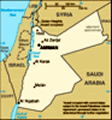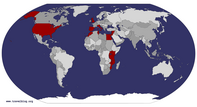Advertisement
Published: March 15th 2007
It takes 20 minutes for the minibus in Aqaba to fill: a few dour old women shuffle in with plastic shopping bags, a man in a red-checkered
kuffiyah limps in with a gnarled wooden cane. He makes a few wisecracks clearly delivered at my expense. “Enjoy the ride, young American,” his wrinkled face suggests. “It is my sincerest wish that a goat’s foreskin finds its way into your morning coffee.” I take a seat in the back, beside two cocky young guys puffing on a pack of L&M’s. They look my way and then exchange a couple of signals with their eyebrows, the implications of which I can’t quite suss out as the driver whips us into oncoming traffic.
We’ve hardly gone a mile before one of the guys offers me a smoke. He makes small-talk - about Jordan, about American women - and then slouches in his seat. We drive in silence; there are broad, flat, barren plains beside us, rugged knobs of stone shaped by centuries of desert winds. About ten minutes pass before he starts up again. He leans close to my ear and says, “Sex,” in a voice I’d almost describe as sultry. Then
he leans back in his seat, his eyes twinkling, his eyebrows arched in a provocative way that implies this two-hour ride is about to get much, much longer.
It’s a bit tough to put my finger on just what he’s getting at; then, with a flash of inspiration, he pulls out his cell phone and starts to fidget with the buttons. Suddenly a young American co-ed is on the screen, reclined and spread-eagled and doing things to a couple of engorged members that suggest she doesn’t spend her sleepless nights cramming for mid-terms. “Yeah, oh yeah,” says a voice off-screen. “Yeah yeah yeah.” When the video is through - after a minute and forty-two seconds best described as “awkward” - he plays another, and then a few more. He gives me an enthusiastic thumbs-up as a young jock offers an insightful lesson in amateur proctology. At this point, it’s worth applauding the Nokia corporation for its recent technological innovations. Thanks to advances in picture resolution, the N-series casts the company’s claim of “connecting people” in a whole new light.
For the next half-hour I’m exposed to more turgid cocks than I expected to find in a
full month in Jordan. It’s these little cultural twists and turns that are, I suppose, the reason we travel. While he searches through his archive his friend leans over from the seat in front of me. He offers his own phone, where some poignant melodrama is playing out to the tune of a popular Lebanese rock ballad. A few cheesy music videos are, admittedly, a welcome diversion, and my eyes are fixed to the screen, not least because my neighbor has decided that now’s the perfect time to start rubbing his crotch. The minutes that follow will hopefully prove to be the most uncomfortable I meet with this week - or, at the very least, this afternoon.
There’s a brief, awkward parting in Wadi Musa; I fork over a couple of condoms, after some dubious claims about a girl in Amman, and offer heartfelt apologies - over their desperate entreaties - that I don’t have any porn of my own to share. It’s a strange introduction to one of Jordan’s highlights: the remarkable rose-hued city of Petra, a site being feverishly promoted by the government during voting for the new
Seven Wonders of the World. Within the hour I’ll be wandering down the
endless rock-carved corridor of the Siq - the kilometer-long gateway to the ancient city - catching my first glimpse of the Treasury’s pink, sun-kissed façade. In a city of countless small miracles, its soaring columns and sculpted cornices have become the most famous icon. Fans of the Indiana Jones franchise will remember its exterior from
The Last Crusade - a film that the budget hotels in town seem to play on an endless loop. There are gaggles of tourists posing in the front, slack-jawed and snapping away, while the young Bedouin guys who offer carriage rides through the Siq make lusty overtures at some Scandinavians in low-rise jeans.
The Bedouins - those famous desert nomads - are everywhere around Petra: selling souvenirs or offering donkey rides to the “High Places,” or pacing the rocky outcrops with their
kuffiyahs flapping in the wind. It’s no surprise they should claim this place as their own. With a culture that pre-dates the birth of Islam in the Middle East, they’ve called this harsh region home for thousands of years. It wasn’t until Petra was officially recognized as a World Heritage Site by UNESCO that the Jordanian government - anticipating a boost in
tourism - decided the Bedouins were ready for fancier digs. Most were relocated to Um Sayhoun, a gray village of concrete apartment blocks a half-hour’s walk from Petra. However modestly at first - and however reluctantly, as many will add - these hardened nomads were being pulled into the modern age. Today young Bedouins surf the ‘Net and blow off classes at the local high school; they download shitty pop ballads on their cell phones and copy the dance moves they’ve seen on MTV Arabia.
They’ve also been forced to adapt to a life of hawking tourist schlock. You see the women around Petra sitting Indian-style next to tables of souvenirs, selling cheap necklaces and jewelry boxes and bracelets made from “Bedouin silver.” Scruffy little kids sell colored rocks and the fragments of pottery you find scattered in the pink sand. An old man stops to barter with me for what he claims is an ancient Nabatean relic: a clay oil lamp about the size of my palm, a crude scene of sexual congress etched into its face. After some small debate he trades me for a Master lock and a vial of citrus oil I picked up in
Tunisia. A young Bedouin boy nearby, mischievously eyeing the scene on the lamp, says, “Someday, when you get married in America, you can do that with your wife.” It’s a sweet moment graced by the boundless innocence of youth, and I’m not entirely sure how to explain to this rosy-cheeked kid the concept of the one-night stand.
For many it’s been a rough transition, going from the crude demands of a nomad’s life to an even cruder life of commerce. But while the Bedouins I’ve met seem to be adept salesmen, they’re always quick to fall back on their famous hospitality. Shahdi, a handsome young merchant, offers me a smoke after a long day of scrabbling up Petra’s rocky paths. There’s some cultural anxiety at work here: what exactly do you give the guy who’s invited you into his cave? A new juicer? A Tupperware set? We dig into a bowl of hummus I’d brought for an afternoon picnic, while his kids scoot over a pile of rocks nearby, and a couple of pudgy Brits huff their way up the mountain.
I spend a few long afternoons exploring the city, making my way to the “High
Places” with sweeping views of the valley. These savvy Bedouins are everywhere, their souvenir stalls lining the path that steeply climbs toward the Altar of Sacrifice. At the top I find a café improbably perched on a cliff’s edge, its plastic lawn chairs and goat-hair carpeting enjoying some of Petra’s finest views. Walid, strumming a ute while his young son gurgles nearby, offers me a sweet glass of tea: “Bedouin whiskey,” he claims. I bounce little Bashar on my lap while Rhoda, a pretty 19-year-old, checks her make-up in a jagged piece of mirror. She wants to know if I’m married. Before I go Walid’s wife comes over with a tray of jewelry. “For your girlfriend,” she suggests. “For your mother.” I buy a small “Roman coin” of dubious origin from Walid, blaming the sweet, burbling Bashar for making the hardest pitch of all.
That night I meet a few young Bedouins having tea at a local restaurant. They welcome me at their table, offering me a pull from their “hubbly-bubbly” - an unfortunate bit of Jordanian slang for
sheesha. It’s not every day you meet a bunch of kids who can earnestly offer to show you the caves
where they were born. We talk about life in Um Sayhoun, and the growing pains as Bedouin culture adapts to the 21st century. While they all live in the village now, Amer, a fiery 22-year-old, explains that his father - cut from the old Bedouin stock - still lives in one of the thousands of caves tucked into the mountains around Petra. He herds his sheep and goats and occasionally calls home on his cell phone. “He doesn’t like the life of the city,” he says, referring to their little Bedouin hamlet. “He makes a face whenever he comes to visit. He’s happier in his cave.”
But for his father, and the older generation of Bedouins, there’s a growing estrangement from the lives of their children. Amer and his friends go to university; most young Bedouins will eschew the shepherd’s life for careers as doctors and teachers and small business owners. But Amer insists his father doesn’t begrudge him for his choices. “He understands life is different for us,” he says with a shrug. “He knows we are happier like this.”
Not all of the older generation, though, is without its regrets. Adnan, a grinning young guy who
takes languorous pulls from his water pipe, talks about his own father. “He has his goats in the mountains, near where I was born,” he says. “He sold one to another man, a neighbor, but it was too painful for him.” He puffs a plume of smoke toward the café ceiling. “So the next day he went to get his goat back. He missed it too much.”
Advertisement
Tot: 0.1s; Tpl: 0.012s; cc: 5; qc: 28; dbt: 0.0577s; 1; m:domysql w:travelblog (10.17.0.13); sld: 1;
; mem: 1.1mb











